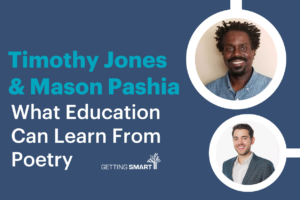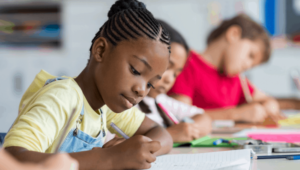How Challenge Based Learning Helps Students Around the World Make a Difference on the Sustainable Development Goals
Key Points
-
While there are many frameworks for hands-on, project-based learning, Digital Promise embraces Challenge Based Learning for its ability to empower students and teachers to be co-learners.
-
The framework encourages students to determine the questions that can lead them to solving their challenge and the steps to discovering what they need to learn.

By: Elyse Gainor
At first glance, you might not be able to locate the teacher in Greg Zapasek’s class at Notre Dame High School in Ottawa, Canada. Instead of stationing himself at the head of the classroom, Greg Zapasek is working alongside individual students, conferencing with a small group of students, or triaging between different student groups on projects related to environmental sustainability. Similarly, just over 5,000 miles away in Lagos, Nigeria, Caleb British International School teacher Victor Okosun takes on the role of facilitator and coach to his students who are developing an eco-friendly refrigerator to help local farmers extend the shelf life of their produce.
What connects both classrooms is Challenge Based Learning, a framework for learning while solving real-world challenges. This framework anchors the Ciena Solutions Challenge, a global design challenge run by Digital Promise and Ciena where students create solutions addressing the UN Sustainable Development Goals (SDGs) in their communities. The SDGs are a collection of 17 interlinked goals for all countries to end poverty, protect the planet, and ensure that by 2030 all people enjoy peace and prosperity. Through the three phases Engage, Investigate, and Act, Challenge Based Learning invites learners to identify big ideas, ask questions, identify and solve challenges, gain in-depth subject area knowledge, develop 21st-century skills, and share their learning.
Challenge Based Learning and the Sustainable Development Goals
While there are many frameworks for hands-on, project-based learning, Digital Promise embraces Challenge Based Learning for its ability to empower students and teachers to be co-learners. The framework encourages students to determine the questions that can lead them to solving their challenge and the steps to discovering what they need to learn. The process supports teachers to act as facilitators and mentors as they learn and problem-solve alongside students, and collaboratively develop a solution to address their challenge.
“My role as the educator felt more like that of a coach, collaborating with students and offering support as they participated in their challenges,” said Greg Zapasek.
Because Challenge Based Learning helps cultivate authentic, student-driven learning experiences, it serves as a great scaffold for taking action on the SDGs in ways that are relevant to students’ personal lives and local communities. This is demonstrated by over 2,200 students around the world and their teachers–like Greg and Victor–who participated in the Ciena Solutions Challenge. We profile two of these teams from India and Zimbabwe who received a Ciena Solutions Challenge Sustainability Award to sustain and scale their projects.
Taking Action on Good Health and Wellbeing in Purulia, India
Located in Purulia, West Bengal, India, a team of high schoolers and their teacher Susmita Roy Chowdhury at Santamayee Girls High School used the Challenge Based Learning framework to take action on hunger (Goal 2), good health and well-being (Goal 3), and decent work and economic growth (Goal 8).
The team says their community is facing challenges such as high rates of unemployment and child malnutrition. Starting with the big ideas of combating malnutrition and empowering women financially, their essential question asks “How can we solve the prevailing rate of hunger and malnutrition in our community?”
The team conducted surveys with adults and children in their community to learn more about their personal experiences accessing nutritious food. They consulted with nutritionists to learn about what constitutes a healthy diet, and along the way met a team of researchers and scientists at Sidho-Kanho-Birsha University who introduced them to pisciculture.
With the help of scientists and researchers, they learned about the nutrients in small fish in their local waterways and discovered which types of fish are the most nutritious. After learning about ring pisciculture, they are working toward developing a fish farm on school grounds. The fish farms will be operated by senior students and women in the community who can earn income from cultivating the fish.
“Teaching the students in the classroom [in a didactic style] and guiding them on a Challenge Based Learning Project are two completely different experiences because in the classroom, the students mostly follow in the teacher’s lead but in this kind of project, it is their thinking and performance that directs the overall progress,” said Susmita Roy Chowdhury. “So, as a teacher, it provided me an opportunity to witness how my learners react when faced with challenges, how they think and work as a team and how they implement their ideas into working models and that helped me understand my students a lot better than teaching-learning in a [didactic] classroom environment can ever do.”
Taking Action on Quality Education in Bulawayo, Zimbabwe
In 2017, the Ministry of Primary and Secondary Education of Zimbabwe introduced a new competence-based curriculum incorporating the use of education technology. However, teacher Jobert Ngwenya and students at Eveline High School in Bulawayo, Zimbabwe, recognized that there were few quality learning resources meeting the new standards. The team used the Challenge Based Learning framework to take action on quality education (Goal 4) and sustainable cities and communities (Goal 11).
Starting with the big idea of 21st century learning, the team’s essential question asks “How can we provide free digital content for learning areas that are under-resourced?” Layered within this challenge were their desires to document, record and promote local history and culture, and encourage the use of mobile technology as a learning tool. They explored their essential question by researching readily available printed and online content in history, economic history, and heritage studies reflecting the new standards; comparing the average cost of textbooks with the average income of people in their region; and conducting a survey with students on their access to mobile devices and the internet.
Based on the results of their research, they created Ilifa Lethu, a podcast through which they share information from difficult-to-access textbooks, local museums, people in their community who hold historical and cultural knowledge, and others with expertise in Zimbabwean culture and history. Their podcast is designed to provide more educational content for students in their community and share important cultural and historical knowledge to their community at large. They plan to scale up production by hosting more educational interviews, visiting and recording information from Matopo World Heritage Site, and getting their podcast disseminated through local radio.
Reflecting on the experience, Jobert Ngwenya says, “The Challenge Based Learning framework is a useful tool for addressing the SDGs because it provides a multidisciplinary, structured approach to problem-solving that engages learners in real-world challenges and encourages them to develop practical, feasible, and sustainable solutions that can make a positive difference in the real world.”
Elyse Gainor is a Program Director at Digital Promise. Elyse works on initiatives supporting youth voice and innovation, including the Ciena Solutions Challenge, a global design challenge for middle and high school youth, and the YouthMADE Festival, a global celebration of youth creativity and innovation.




0 Comments
Leave a Comment
Your email address will not be published. All fields are required.